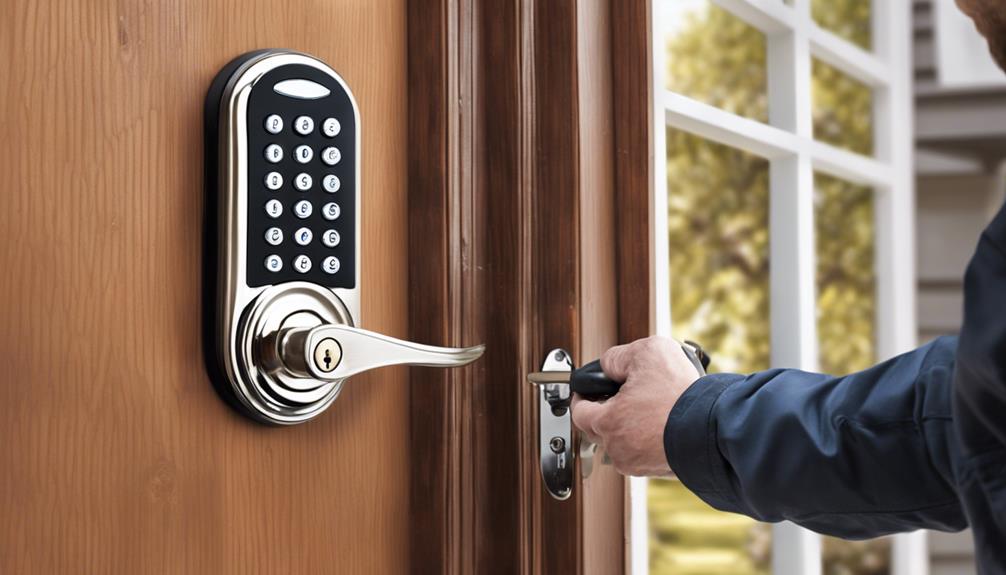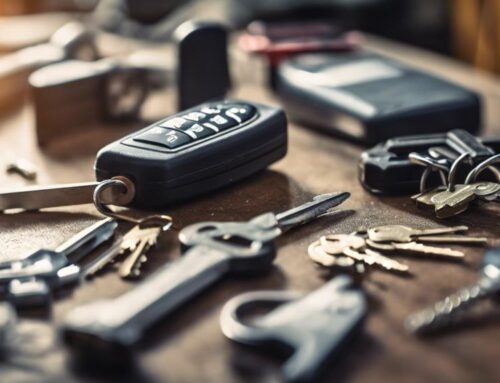Yes, a locksmith can install a keyless entry system for you. These professionals are skilled in setting up various types of electronic and biometric systems, from keypads to fingerprint sensors. When you hire a locksmith, they’ll handle the entire installation process, which includes removing your old locks, installing new hardware, and making sure everything is synced correctly. This guarantees a smooth shift to a more secure, keyless environment. They are also equipped to assess compatibility with your existing door hardware and integrate the new system effectively. For a reliable setup and peace of mind, consider hiring a skilled locksmith. More insights await as you explore further options available.
Keyless Entry Overview
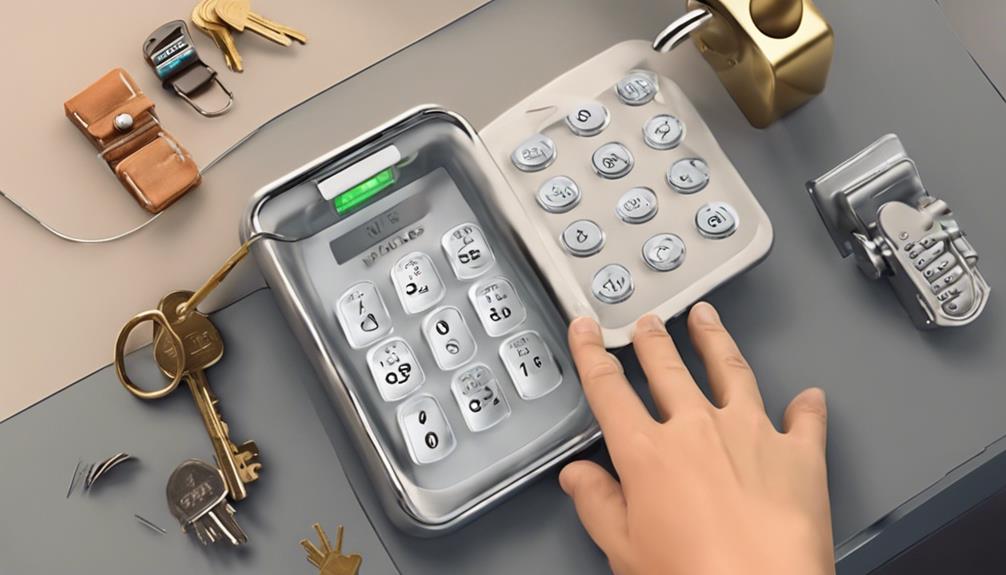
Keyless entry systems let you access doors without a physical key, offering methods like keypads and biometric access for improved security. Imagine ditching those medieval metal keys for something as cool as smart locks and electronic door gadgets! These aren’t just nifty; they’re a big leap into the future of door security. With a keyless lock, you can forget the panic of losing keys because your finger or a code is all you need. It’s like having a secret handshake with your house! Plus, these systems aren’t just about convenience; they enhance security by allowing you to manage access remotely. So, you can keep tabs on who’s entering your fortress without needing to peek through the curtains.
Choosing the Right System

When selecting the correct keyless entry system, you must evaluate your security needs and determine which features match your property’s requirements. It’s essential to check if the new system will be compatible with your existing hardware to avoid unnecessary complications. Consider systems that offer various access methods, like PINs or biometric options, to guarantee flexibility and security.
Assessing Security Needs
To choose the best keyless entry system, you must first assess your property’s specific security needs. Think of it like picking a guard dog—do you need a friendly Labrador or a fierce Rottweiler? Consider the size of your building, the number of entry points, and just how Fort Knox-ish you want to go. Are you looking for something basic to keep the riff-raff out, or do you need the high-tech jazz like biometric scanners that read fingerprints or eyeballs? Picking the right locks and access features is essential, ensuring your security system isn’t just a fancy electronic doormat. Make sure it fits like a glove with what your property can handle without going overboard.
Compatibility With Existing Hardware
After assessing your property’s security needs, it’s important to make sure the keyless entry system you choose harmonizes well with your existing door hardware. Let’s face it, you don’t want to pick a fancy new system that throws a techno-tantrum with your old-school locks! Consulting a locksmith can save you from such a drama. They’ll help you find a keyless entry system that gets along with your current setup like old friends. This compatibility not only eases installation but also keeps those pesky installation costs from skyrocketing. Remember, not all keyless entry systems are willing to buddy up with your existing hardware, so choose wisely to avoid turning your entryway into a high-tech battleground.
Installation Process
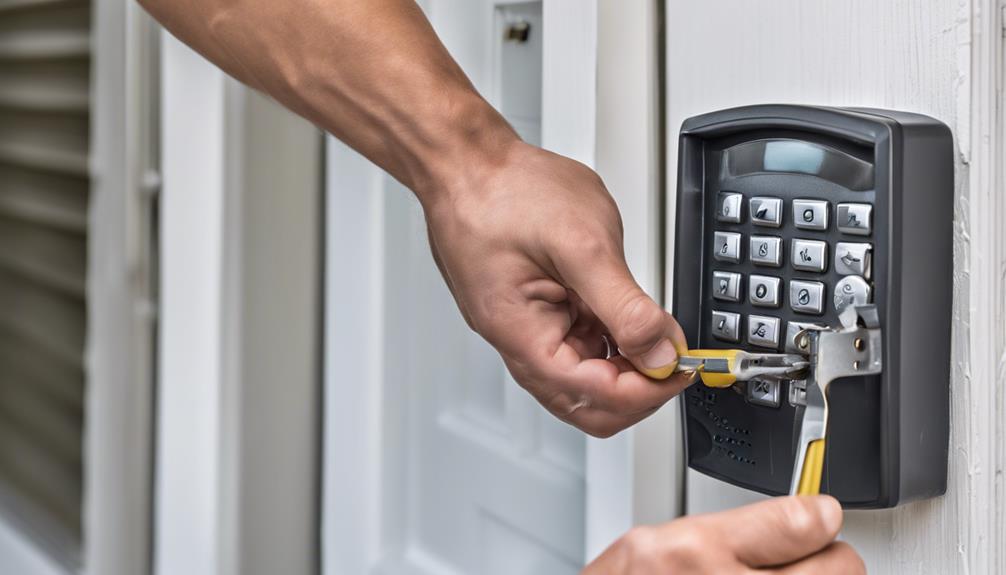
You should first contact a certified installer recommended by the system manufacturer to guarantee a professional setup of your keyless entry system. After all, you wouldn’t want just any Joe Schmo fiddling with your fancy new tech, would you? This isn’t just any old locksmith service; it’s an upgrade! The professional locksmith will replace your tired, old door locks with shiny, new electronic ones. They’ll run wiring, install keypads, and make sure everything’s synced up. Installation isn’t just about lock installation; it’s about transforming your entryway into Fort Knox, minus the gold. So, let the locksmith services handle the nitty-gritty while you sit back and dream of all the keys you won’t miss.
Benefits of Keyless Entry
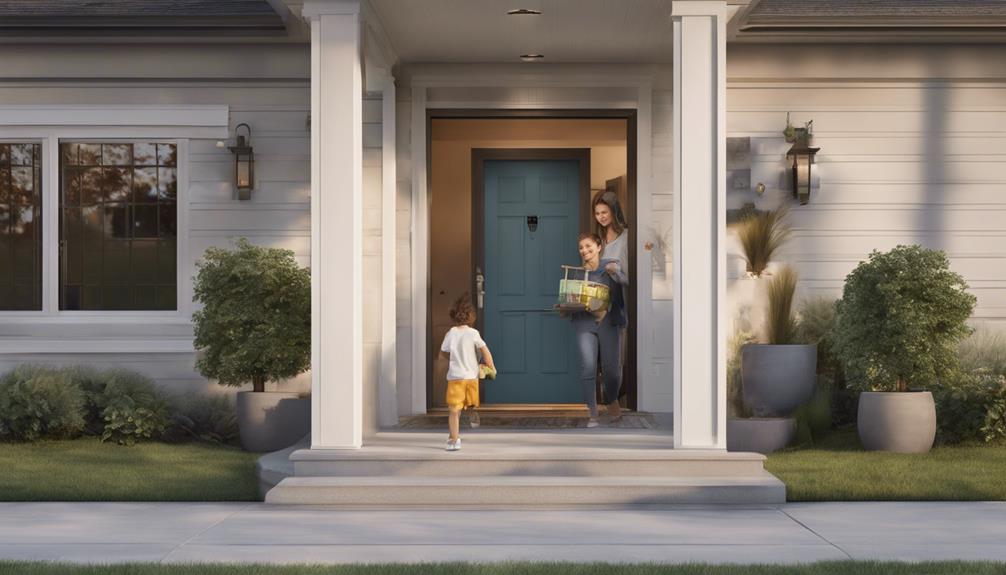
Keyless entry systems boost your property’s security by removing the need for physical keys and reducing the risk of unauthorized access. These smart systems aren’t just cool gadgets from spy movies; they’re practical, real-world solutions to keep the baddies out. With electronic access control, you can manage who gets in and when, all from the comfort of your phone or computer. Forgot to give the dog walker a key? No problem! Just a few taps and they’re in. And let’s talk about biometric locks – using your fingerprint to get in feels a bit like you’re a secret agent, right? Plus, these systems are a breeze to use, making your life both simpler and more secure.
Cost Analysis

Installing a keyless entry system typically costs between $500 and $2,500 per door, depending on various factors. You might wonder if shelling out that much cash means the system will brew your morning coffee—sadly, no. However, the type of system, hardware needs, your building size, and number of doors play a massive part in the bill. It’s not just about sticking a fancy gadget on your door; it’s an art—and you want it done right. Hiring certified installers, who are often recommended by system manufacturers, can ease your pain. They’re like the superheroes of installation, swooping in with their expertise to make sure your keyless entry system isn’t just installed, but installed perfectly.
Common Keyless Systems
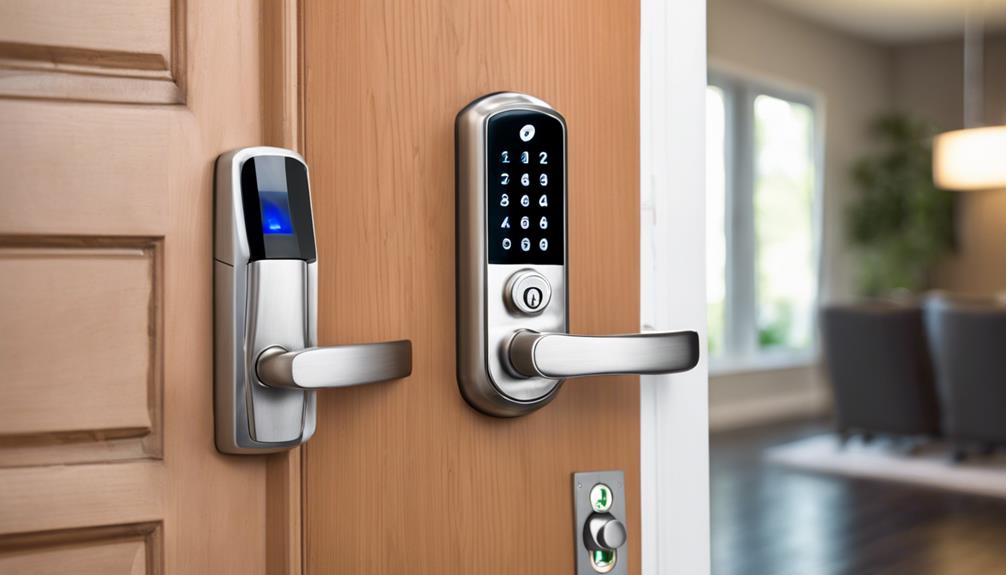
While considering the cost implications, it’s also important to understand the types of keyless entry systems available. You’ve got a smorgasbord of options ranging from smart as a whip electronic locks to James Bond-esque biometric systems. Let’s break it down:
| Type | Description |
|---|---|
| Smart Locks | Keypad or touchscreen; send keys via smartphone. |
| Motorized Locks | They hustle to open your door with a button press. |
| Gate Locks | No key? No problem. Remote operation for the win. |
| Biometric Locks | Your fingerprint is your key. Top-secret agent style! |
Each of these keyless wonders offers you convenience and enhanced security. So, why fumble with keys when your entry can go high-tech?
Maintenance Tips
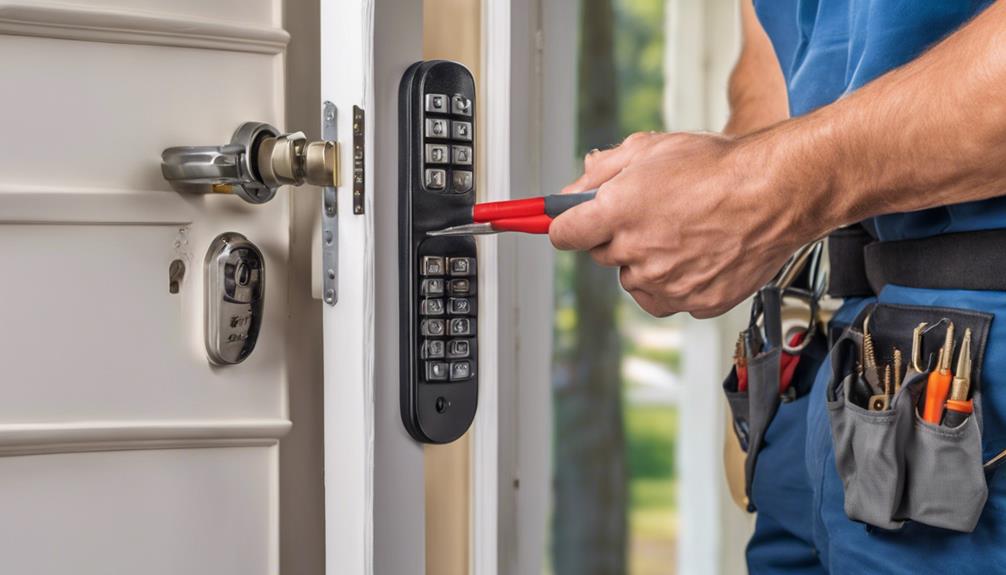
To guarantee your keyless entry system running smoothly, regularly clean and inspect all its components for any signs of dirt or debris. It’s like giving your system a spa day; except you’re scrubbing electronic locks instead of backs! Always check and replace the batteries—don’t let a dead battery lock you out of your fortress of solitude. Test the system’s functionality often; think of it as a monthly ‘Are you still there?’ check. Don’t forget to update the system software. Keeping it fresh helps fend off the digital gremlins. Finally, buddy up with your locksmith technician for annual maintenance checks. They’re the superheroes who make sure your keyless entry isn’t just keyless but trouble-less too!
Security Enhancements
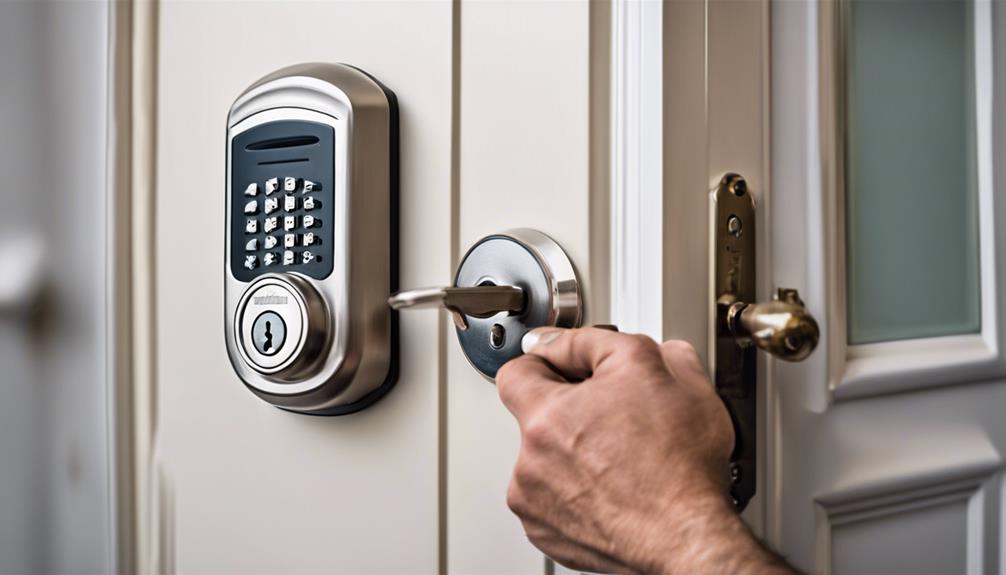
Keyless entry systems enhance your property’s security by removing the risks associated with lost or stolen keys. Imagine never having to turn your house upside down just because your keys decided to play hide and seek! With a keyless entry system, installed by your trusty locksmith, you’re upgrading to a fortress of solitude—minus the ice and loneliness. These systems offer secure access control, letting you choose who gets in with just a PIN or a biometric scan. Fancy, right? Your locksmith can seamlessly integrate these systems with your existing security setup, making your life easier and your property safer. It’s like having an invisible bouncer at your door, minus the earpiece and scowl!
Why Hire a Locksmith?
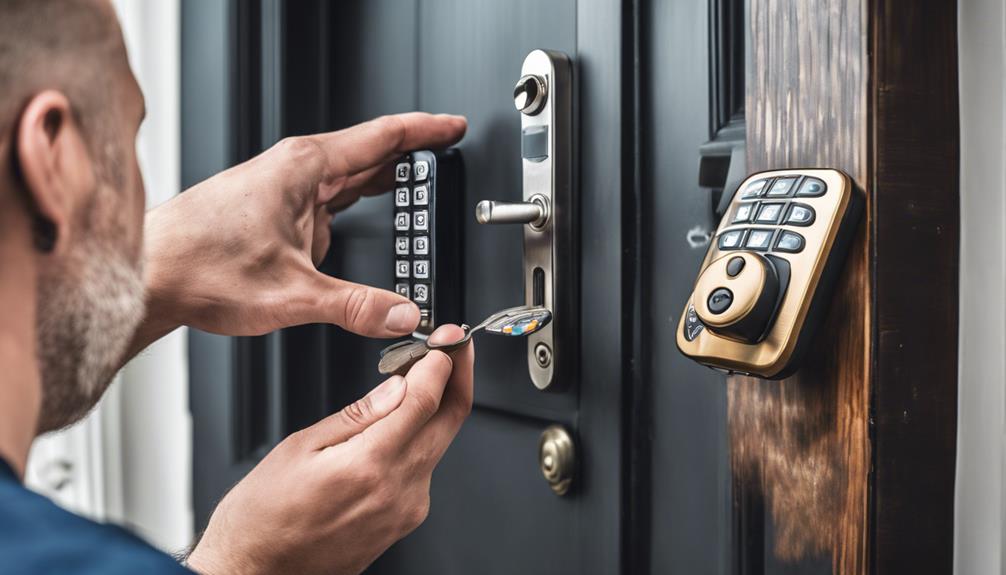
When you’re considering installing a keyless entry system, hiring a locksmith is a wise choice. They have a broad skill set that guarantees the installation is done correctly and securely, minimizing any future issues. Additionally, their expertise in security solutions and reliable service can save you time and enhance your property’s safety.
Expertise in Security Solutions
Locksmiths possess specialized expertise in security solutions, making them your ideal choice for installing keyless entry systems. They’re not just key cutters; they’re like the Swiss Army knife of security! Fancy a high-tech upgrade? They’ll seamlessly integrate it with your existing setup. And don’t sweat the techie stuff; they have the installation process down pat.
| Feature | Locksmith Advantage | Why It Matters |
|---|---|---|
| Customization | Tailored security solutions | Fits your specific security needs |
| Expertise | Trained in various security systems | Ensures top-notch setup |
| Support | Offers maintenance and troubleshooting | Keeps your system running smoothly |
Reliable and Timely Service
You’ll appreciate the quick and dependable service that professional locksmiths provide when installing keyless entry systems. When you’re ready to switch from the dingy old keys to something a bit more high-tech, having a locksmith at your service guarantees that your shift to a keyless entry system is as smooth as a freshly oiled lock. With their reliable service and timely installation, you won’t be left hanging around like a forgotten coat. Instead, you’ll be quickly securing your fortress with just a few taps. Why settle for DIY mayhem when you have experts who make sure your system clicks into place perfectly? Remember, locksmiths are the key (pun intended) to a swift and secure keyless entry system setup.
Comprehensive Skills Set
Hiring a locksmith guarantees your keyless entry system is installed with precision and expertise. You’ll be chuckling at how easy they make it look, like magicians with a digital wand! Here’s why you should trust a locksmith with your tech:
| Skill | Benefit |
|---|---|
| Expert Installation | Ensures secure, efficient operation |
| Hardware Knowledge | Handles various keyless systems adeptly |
| Seamless Integration | Merges with your existing security setup |
| Ongoing Support | Provides troubleshooting and maintenance |
Contact Low Rate Locksmith
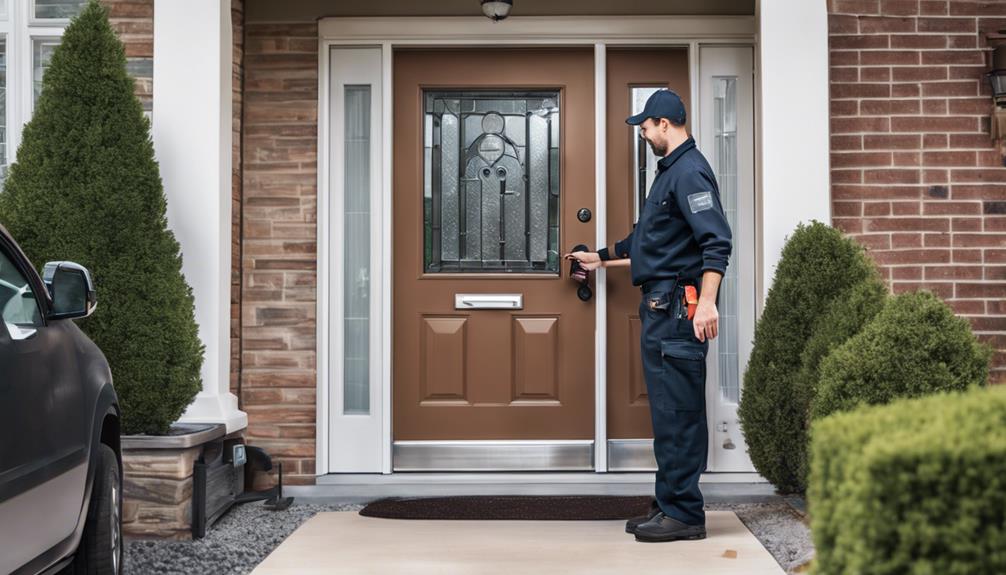
To arrange for the installation of a keyless entry system, contact Low Rate Locksmith directly. They’re not just your average locksmith; their installation services are exceptional, and they’ve got the skills to prove it. Imagine entrusting your keyless entry system to someone less qualified and coming home to a door that greets you with a riddle instead of a welcome! Thankfully, Low Rate Locksmith’s certified technicians are all about efficiency and reliability, sans the riddles. Plus, their rates won’t have your wallet locking itself away in fear. And yes, they take credit cards, so no need to start digging under the couch cushions for spare change. Just give them a ring, and you’re set!
Frequently Asked Questions
Can Keyless Entry Systems Be Integrated With Smart Home Devices?
Yes, you can definitely integrate keyless entry systems with smart home devices like Amazon Alexa, Google Assistant, and Apple HomeKit. This setup allows you to secure and release doors, check their status, and receive notifications right on your smartphone or through voice commands. It’s a nifty way to boost your home’s security and convenience, making life a bit easier. Just imagine telling your house to secure for the night!
Are Keyless Systems Weather-Resistant for Outdoor Use?
Yes, keyless entry systems are designed to be weather-resistant, especially for outdoor use. They’re often made from tough materials like stainless steel or aluminum to prevent rust and withstand harsh conditions. Many models have IP65 or IP66 ratings, ensuring they resist water and dust effectively. These systems also feature sealed components and protective covers, making them ideal for gates, garages, and exterior doors where exposure to the elements is inevitable.
How Long Do Batteries Typically Last in Keyless Systems?
You’ll feel like time is flying when you’re not worrying about battery changes! Typically, batteries in keyless entry systems last anywhere from 6 months to a whopping 2 years. Of course, that depends on how often you use it and the quality of the batteries. For the best performance, stick to high-quality alkaline batteries. Some systems even have handy indicators to tell you when it’s time for a change. Always good to keep an eye on that!
Can Existing Keys Be Used With New Keyless Entry Systems?
You can’t use your existing keys with new keyless entry systems. These modern systems don’t work with traditional keys because they rely on digital methods like PIN codes, mobile apps, or biometrics for access. This means you’ll need to embrace the digital credentials, which offer enhanced security and convenience compared to old-school keys. So, stash those old keys away; you won’t be needing them to tap into today’s keyless wonders!
What Are the Insurance Implications of Installing Keyless Entry?
You might not know this, but installing a keyless entry system can actually lower your insurance premiums. Since these systems beef up security, insurers often see less risk of break-ins and unauthorized access, which can lead to discounts. If you’re thinking about adding one, don’t forget to give your insurance provider a heads-up to potentially nab some savings. It’s a smart move that keeps your wallet and property safer!

